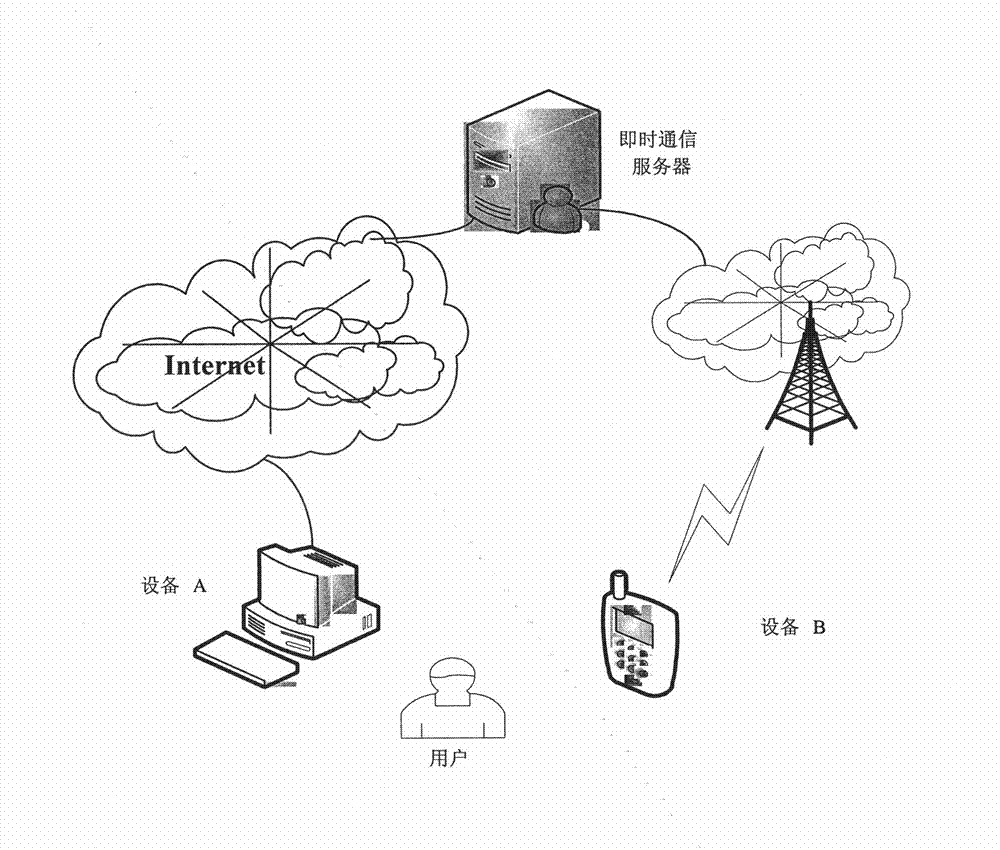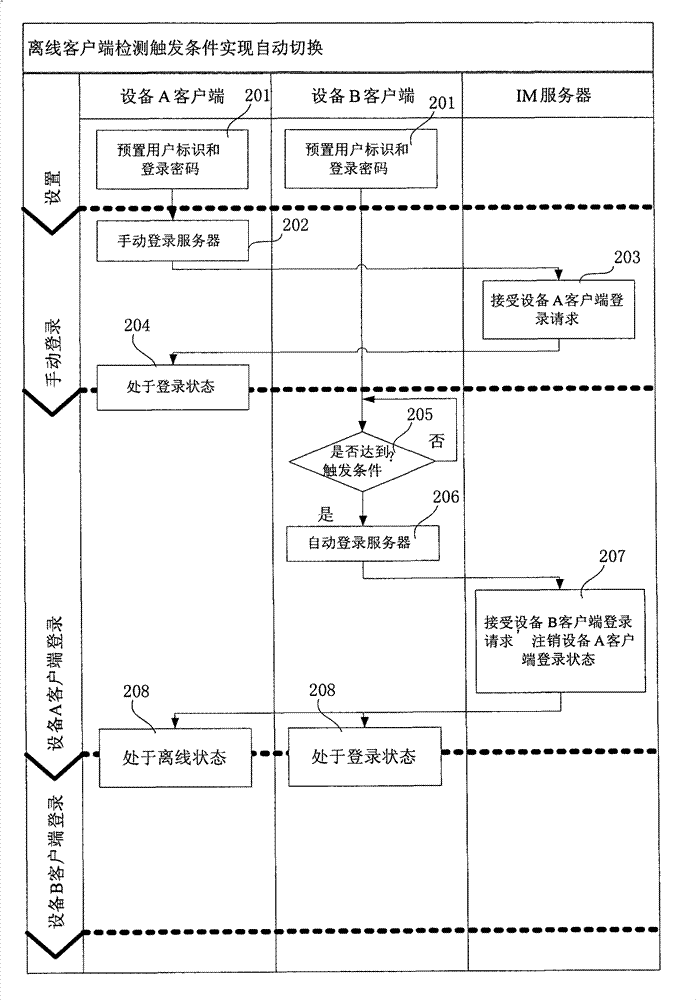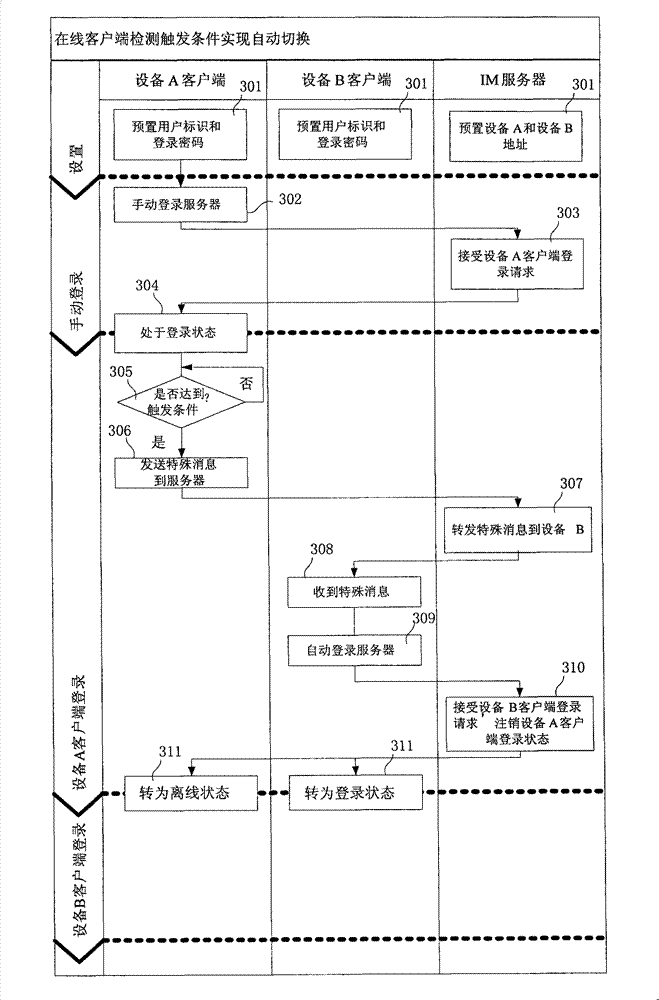Method and system for switching instant messaging service between clients
A client and business technology, applied in the field of mobile communication, can solve the problems of abandoning the user's PC client's ease of operation and users' inability to log in at the same time, and achieve the effect of overcoming the relative difficulty of text input, overcoming mobility, and achieving continuity.
- Summary
- Abstract
- Description
- Claims
- Application Information
AI Technical Summary
Problems solved by technology
Method used
Image
Examples
Embodiment approach 1
[0081] To achieve the stated purpose, the present invention provides a method for automatically switching login states between clients of different terminal devices. In this method, a client that is not currently logged in detects a trigger condition and initiates a login, and the instant messaging server cooperates to realize the method.
[0082] Wherein, the instant messaging server supports the priority of the last-login client of the same user, that is, before the login request of the late-login client triggers the logout of the instant messaging server, when the same user is already in the login state, switch to the last-login client. See attached figure 2 shown, including the following steps:
[0083] Step 201, fill in the user identification and password in the instant messaging client on the terminal equipment A and B in advance, and set both to save the user identification and password. Wherein, the user identifier may be a virtual number, an email address, or an in...
Embodiment approach 2
[0089] The present invention also provides a method in which an instant messaging client in a login state detects a trigger condition, and notifies another client in an offline state to initiate a login request through an instant messaging server, so as to realize automatic login status between different terminal device clients. The method of switching.
[0090] Among them, the instant messaging server supports the login client after the same user is preferred. See attached image 3 shown, including the following steps:
[0091] Step 301, fill in the user identification (which can be a virtual number, email address or SIP URI, etc.) and password on the instant messaging client on the terminal equipment A and B in advance and set them to save the user identification and password. Set the addresses of terminal device A and terminal device B on the IM server through the client. If the terminal device is a PC, its address is set to the current IP address. If the terminal device is...
Embodiment approach 3
[0098] The present invention also provides an instant messaging client on two terminal devices that is in the login state, but at the same time one of the clients is in the active state and the other client is in the dormant state, both clients can detect the trigger condition and request The IM server changes the activation / sleep state of the two clients to realize the switching method, see the attached Figure 4 shown, including the following steps:
[0099] Step 401, when a new user applies for an instant messaging user identification ID1 (which can be a virtual number, an email address or a SIP URI, etc.), the instant messaging server distributes a secondary user identification ID2 (which can be a virtual number, an email address or a SIP URI, etc.) ). The two user IDs are bound in the system, that is, they have exactly the same user information, usage rights, and even login passwords.
[0100] Steps 402-405, the user sets user ID 1 on the client side of terminal device ...
PUM
 Login to View More
Login to View More Abstract
Description
Claims
Application Information
 Login to View More
Login to View More - R&D
- Intellectual Property
- Life Sciences
- Materials
- Tech Scout
- Unparalleled Data Quality
- Higher Quality Content
- 60% Fewer Hallucinations
Browse by: Latest US Patents, China's latest patents, Technical Efficacy Thesaurus, Application Domain, Technology Topic, Popular Technical Reports.
© 2025 PatSnap. All rights reserved.Legal|Privacy policy|Modern Slavery Act Transparency Statement|Sitemap|About US| Contact US: help@patsnap.com



